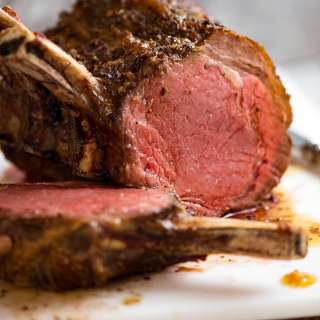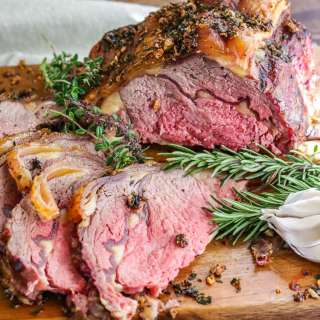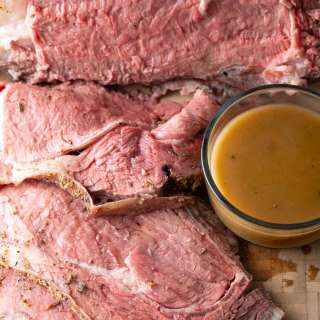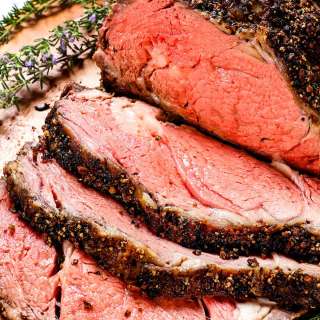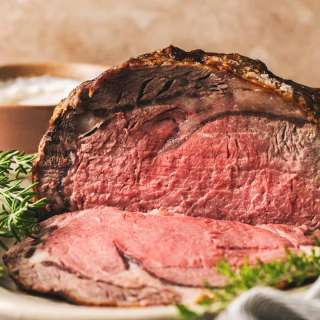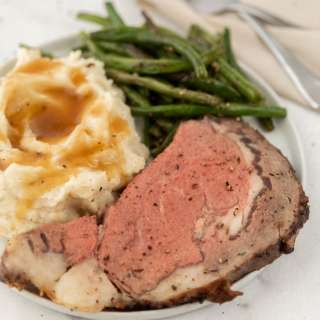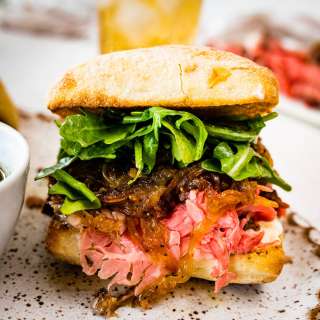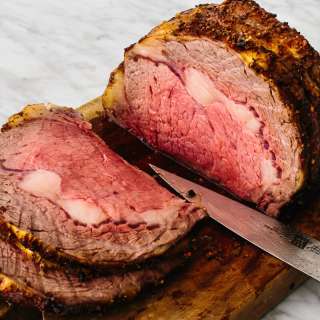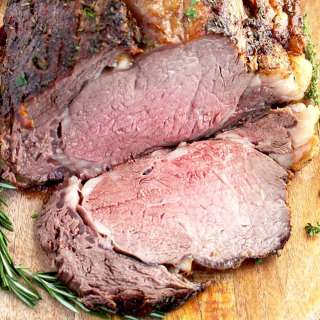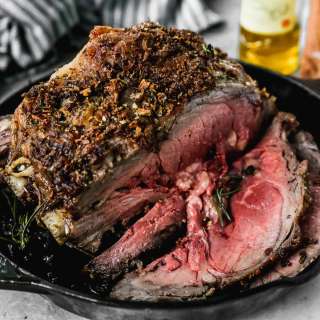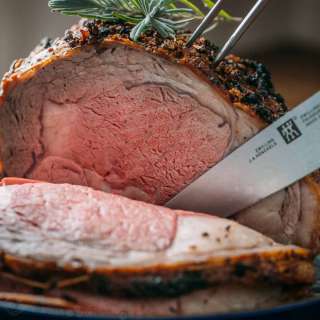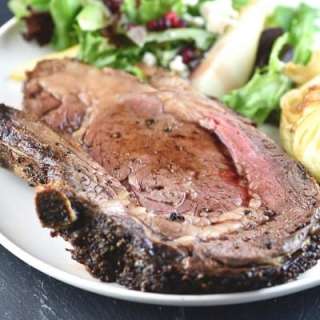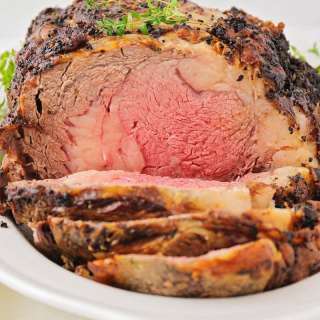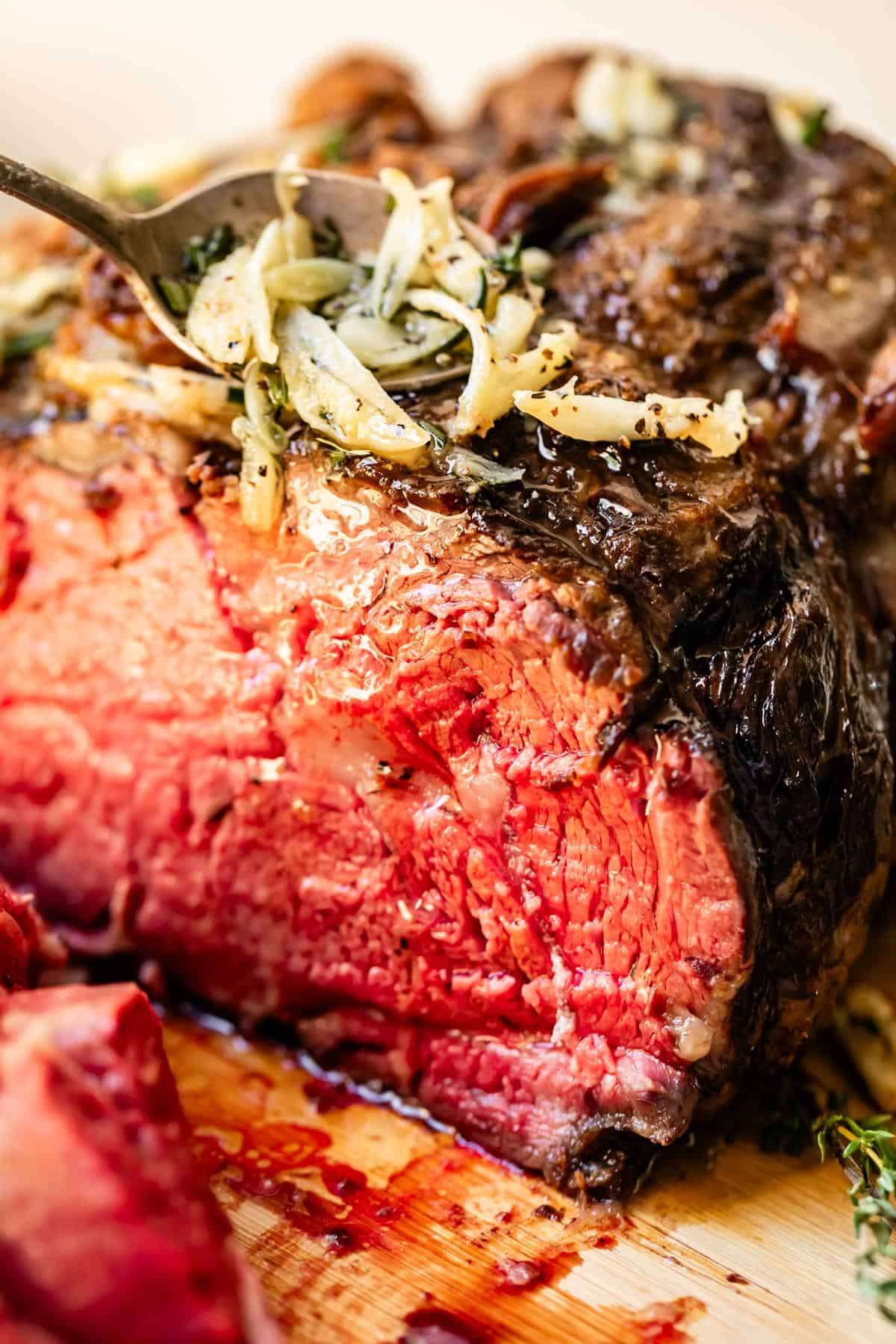
The Best Prime Rib Recipe
User Reviews
0.0
0 reviews
Unrated
-
Prep Time
30 mins
-
Cook Time
3 hrs
-
Chill and rest time
1 d 2 hrs
-
Total Time
1 d 5 hrs 30 mins
-
Servings
8
-
Calories
851 kcal
-
Course
Main Course
-
Cuisine
American

The Best Prime Rib Recipe
Report
I thought prime rib must be overrated. But boy-oh-boy does it live up to the hype! There is something magical about this roast! The whole process can seem daunting, but I'm here to show you how to cook it step by step, with tons of pictures. With the right techniques (plenty of time + salt), you will get the BEST prime rib. It's juicy, tender, and has a unique melt-in-your-mouth flavor. Make this show stopper recipe for Christmas, Easter, or Thanksgiving!
Share:
Ingredients
- 1 pound prime rib roast (3 ribs)
- 2 and 1/2 tablespoons kosher salt see note for subs
- 1/4 cup vegetable oil divided for searing (I used light olive oil)
For the gravy
- 2 cups water
- 1 tablespoon better than bouillon beef base
- 2 cups drippings
- 1 and 1/2 cups water
- 1/3 cup flour
- 1/2 teaspoon black pepper
- 2 tablespoons butter optional
For the Garlic Butter Sauce:
- 1 cup butter (2 sticks)
- 15 cloves garlic
- 2 teapoons granulated garlic
- 3/4 teaspoon kosher salt
- 2 teaspoons fresh black pepper
- 1 and 1/2 tablespoons fresh Rosemary
- 1 and 1/2 tablespoon fresh thyme
Instructions
- Gather your tools: Don't make this recipe without a meat thermometer. I'm serious. This cut of meat is too expensive to mess around with guessing. I prefer a probe meat thermometer that stays inserted into the meat while it's cooking.
- Choose your prime rib: For the best of the best, ask your butcher for prime-grade "first cut" prime rib. These are ribs 10, 11, and 12.
- Talk to your butcher: Ask your butcher to remove the rib bones from the roast and tie them back on with kitchen twine. This is how prime rib is most often sold, so it might already be done, but it doesn't hurt to double check.
- Prep your roast: Gather your ingredients and materials. You need a roasting pan (a cooling rack set over a half baking sheet will do in a pinch), kitchen twine, and kosher salt.
- Cut off the bones: If your butcher didn't cut the bones from the roast, that's the first step. Use a very sharp serrated knife and run it down the length of the bones, staying as close to the bone as you can, following the rounded bottom of the roast. See photos.
- If your butcher already cut off the rib bones: Your roast will be tied to the rack of bones with twine. Cut the twine and separate the roast from the bones. Take note of which way the roast is sitting on the bones! Set the bones aside.
- Score the fat. Place the roast fat-cap-side-up on a cutting board. Use a sharp serrated knife to score the fat cap in a crosshatch pattern. Do not cut into the meat itself. See photos. These cuts help the salt to penetrate into the muscle below, tenderizing it before it even hits the oven.
- Salt the roast. Rub 2 and 1/2 tablespoons of kosher salt all over the roast. Get it in every nook and cranny! Rub it over the side that you cut the ribs from. Get your fingers in there and rub the salt into the crosshatch slits you just made in the fat cap. Use a little extra salt and rub the bones top to bottom, as well.
- Place the roast on a rack. You need your roast to sit on a rack, so that the juices don't pool at the bottom while it chills. A cooling rack set over a half baking sheet is fine, or if you can fit your whole roasting pan in your oven, that works too. Set the bones down first, then set the roast on top. There is no need to tie them together with twine right now; we will be separating them again to sear the roast.
- Refrigerate the salted roast, completely uncovered, for 24 hours. (or up to 48 hours.)
- Bring to room temperature. Let the roast sit on the counter for about 2 hours on the day you are cooking it. If you roast a cold prime rib, it will cook unevenly.
- Preheat your oven to 200 degrees F.*
- Sear the roast. Heat a high-sided 12-inch stainless steel pan over medium high heat. Preheat the pan for about 3 minutes. When the pan is very hot, add about 1/4 cup vegetable oil to the pan and swirl it around. Place the roast (not the bones) in the pan, any side is fine. Sear for 2-3 minutes, until crispy brown on the edge. Use sturdy tongs to flip the roast over and sear another 2-3 minutes. Use the tongs to lift up the roast to sear the edges, holding in place with the tongs for a couple minutes. Remove the roast back to the rack.
- Sear the bones. This is optional. Remove from the pan.
- Make a broth. Add 2 cups of water and 1 tablespoon Better Than Beef Bouillon paste to the pan that you seared the roast in. Turn the heat to high and bring the mixture to a boil, scraping up the browned bits. Pour the broth into the pan that you are cooking the roast in.
- Reassemble and tie the roast. Place the bones on the rack of your roasting pan. (Or, if you don't have one, continue using the cooling rack placed on the rimmed baking sheet. You don't want the roast sitting on a flat surface in it's own juices.) Place the seared roast on top of the bones, situated in the position they were in before they were cut. Use kitchen twine to tie the roast to the bones. You don't want to skip this step! Cooking with the bones insulates your roast and brings a deep, juicy flavor.
- Insert your probe meat thermometer. If you have one, insert the probe of your meat thermometer into the thickest part of the roast in the center. Set the alarm to ring when the internal temperature reaches 110 degrees F.
- Cook your roast. Place the roast on a lower rack of the 200 degree F oven. See notes for cook times if you don't have a probe meat thermometer.
- When the roast registers 115 degrees F, turn off the oven but don't take the roast out. Crack open the oven door. Stick a wooden spoon in it if it won't stay cracked open on its own. The internal temperature of the roast will keep rising.
- When the internal temperature reaches 120, it is quite rare. (Too rare for me, but you can take it out now if you are into that.)
- When the internal temperature reaches 125 degrees in the turned off oven, take it out. 125 is still considered rare.
- Wait until 130 if you like it medium-rare.
- Remove the roasting pan from the oven. Remove the rack with the prime rib on it to a cutting board with a juice groove. Tent with foil and rest for 30 mins (or up to one hour.) Tuck the foil in around the edges so it doesn't lose too much heat.
- Make the gravy. If there is a lot of fat in the pan of gravy, pour the gravy into a fat separator. (If you don't mind a little fat, then just leave it in the pan. Pour the broth from the fat separator back into the roasting pan (Or into a saucepan). Bring the liquid to a boil over high heat.
- Add 1 and 1/2 cups water to a glass measuring cup. Use a small whisk to thoroughly stir in 1/3 cup of flour. Make sure there are no lumps. Once the drippings are boiling, SLOWLY pour in the flour mixture while whisking the drippings constantly. Turn the heat down to medium and let the gravy simmer for about 5 minutes. Add 2 tablespoons of butter and 1/2 teaspoon black pepper. Taste it and add kosher salt if it needs it. If it is not very flavorful, add in 1 teaspoon Better Than Bouillon Beef Base. Pour the gravy into a gravy boat or small pitcher and keep warm (you need the roasting pan to go back in the oven soon for one last broil.)
- Make the garlic butter sauce: Melt 1 cup butter in a small saucepan over medium heat. Thinly slice 15 cloves of garlic. Once the butter is melted, add the sliced garlic, 2 teaspoons granulated garlic, 3/4 teaspoon kosher salt, and 2 teaspoons freshly cracked black pepper.
- Stir over medium heat for 2-5 minutes, until the garlic is fragrant and barely starts to turn golden. Remove from the heat right away. Add 1 and 1/2 tablespoons finely chopped rosemary, and 1 and 1/2 tablespoons thyme leaves. Set aside.
- Broil the prime rib. Once the prime rib has rested 30-60 minutes and you are ready to serve, place the rack with the prime rib back into the roasting pan (there should be no gravy in it!) Remove the foil that is tented, and crumple it into a loose ball. Use tongs to lift the narrow end of the roast, and tuck the ball of foil underneath so that the top of the roast is horizontal to the broiler. See photos.
- Turn the broiler to high heat. Broil for 2-5 minutes, until browned and crispy on top.
- Cut away the kitchen twine. Use tongs to lift the roast away from the rib bones. Transfer the roast (without the ribs) to a carving board. Drizzle the roast with the garlic butter sauce.
- Carve the prime rib against the grain into 1/2 inch slices. Serve with remaining butter sauce, gravy, and Mashed Potatoes.
- Storage: Wait for the prime rib to completely cool to room temperature, put it in an airtight container. Prime rib will be good in the refrigerator for 5-7 days!
- Reheating: Place the remaining standing roast in a 9x13 pan or a roasting pan, with some drippings, broth, or water in the bottom. Cover with foil and reheat at 200 or 225 degrees until heated through, it will take 60-90 minutes.Microwave reheat:I do NOT recommend rewarming in the microwave. It makes your precious prime rib dry and chewy, so sad. But, if you must: Place the prime rib on a plate by itself (NOT next to your mashed potatoes, for heaven's sake. They take eons to reheat.) Cover the plate of prime rib and set the power level on your microwave to at least half power (level 5) or even better, level 2 or 3. You will have to stick around to check it, as all microwaves are different. Start with 1 minute and add more time from there.
Equipments used:
Notes
- Kosher salt: I highly recommend kosher salt for this recipe. If you insist on using table salt, I would decrease the salt called for in the initial rub to about 1 tablespoon + 2.5 teaspoons.
- My guests don't like rare meat: Here's how to please everyone in your party: Cook your roast to the temperature that the person with the rarest preferences likes (rare or medium rare). Slice the roast, and transfer individual slices to a baking sheet, spread out. Move your oven rack to the top of your oven. Broil the slices of prime rib for 30-60 seconds, or longer, depending on what you're going for. Just remember that overcooked prime rib is tough; it's not the same as a slow cooked fall apart pot roast. If you want it tender, it has to be at least a little pink.
- Another option is to heat a pot of high quality beef broth on the stove. Drop individual slices of prime rib into the pot and let cook 30-60 second until the desired doneness is reached. Remove right away and serve.
- *Oven temperature: I prefer to cook my prime rib at 200. If you are in a hurry, you can go up to 225, or even 250, and it will shave off some time. I wouldn't go higher than that!
- Cook times: If you don't have a thermometer that you can leave in the oven, you will need to open the oven, remove the roasting pan, shut the oven door as quickly as you can (to retain heat), and insert your instant read thermometer. Start checking after 2 and 1/2 hours. Be aware that it could take up to 4 hours and you will need to keep checking.
- Final Internal temperatures: remember that the roast will rise 5-10 degrees after you turn off and crack open the oven. The temps below are what you want the END temperature to be when you eat it.
- Rare: 120-125°F
- Medium rare: 130°F
- Medium: 135°F
- Nutrition facts: the nutrition facts includes the gravy AND the butter sauce, which is why the calorie count is so high!
Nutrition Information
Show Details
Calories
851kcal
(43%)
Carbohydrates
7g
(2%)
Protein
1g
(2%)
Fat
92g
(142%)
Saturated Fat
41g
(205%)
Polyunsaturated Fat
12g
Monounsaturated Fat
35g
Trans Fat
1g
Cholesterol
125mg
(42%)
Potassium
59mg
(2%)
Fiber
1g
(4%)
Sugar
0.1g
(0%)
Vitamin A
874IU
(17%)
Vitamin C
4mg
(4%)
Calcium
33mg
(3%)
Iron
1mg
(6%)
Nutrition Facts
Serving: 8Serving
Amount Per Serving
Calories 851 kcal
% Daily Value*
| Calories | 851kcal | 43% |
| Carbohydrates | 7g | 2% |
| Protein | 1g | 2% |
| Fat | 92g | 142% |
| Saturated Fat | 41g | 205% |
| Polyunsaturated Fat | 12g | 71% |
| Monounsaturated Fat | 35g | 175% |
| Trans Fat | 1g | 50% |
| Cholesterol | 125mg | 42% |
| Potassium | 59mg | 1% |
| Fiber | 1g | 4% |
| Sugar | 0.1g | 0% |
| Vitamin A | 874IU | 17% |
| Vitamin C | 4mg | 4% |
| Calcium | 33mg | 3% |
| Iron | 1mg | 6% |
* Percent Daily Values are based on a 2,000 calorie diet.
Genuine Reviews
User Reviews
Overall Rating
0.0
0 reviews
Unrated
Other Recipes
